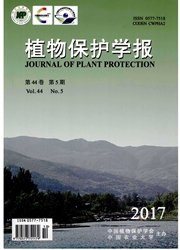

 中文摘要:
中文摘要:
为了明确活性氧(ROS)在莲子草假隔链格孢Nimbya alternantherae侵染空心莲子草过程中的作用,采用氯化硝基四氮唑蓝(NBT)光化学还原法、二氨基联苯胺(DAB)组织染色法和分光光度法测定了莲子草假隔链格孢SF-193侵染空心莲子草后超氧阴离子(O2·-)产生速率、过氧化氢(H2O2)含量、抗氧化酶体系(超氧化物歧化酶(SOD)、过氧化氢酶(CAT)和过氧化物酶(POD))活性和丙二醛(MDA)含量。结果显示,接种莲子草假隔链格孢SF-193的叶片经NBT和DAB染色后检测到ROS的大量累积。叶片内的O2·-产生速率和H2O2含量随接种时间显著升高,接种后48 h均达到峰值,分别为2.33 nmol·min-1·g-1FW和11.78 μmol·g-1FW,是对照的2.1倍和2.5倍;SOD、CAT和POD活性均在接种后8 h达到峰值,分别为277.75、23.47和444.92 U·min-1·g-1FW,之后逐渐下降;MDA含量随接种时间持续上升,72 h时达到峰值,为5.20 μmol·g-1FW。表明莲子草假隔链格孢侵染空心莲子草打破了ROS产生与清除之间的平衡,导致植物细胞内的ROS迅速上升,对叶片细胞造成严重破坏。
 英文摘要:
英文摘要:
In order to elucidate the role of reactive oxygen species (ROS) during the infection of Nimbya alternantherae in leaf of Alternanthera philoxeroides, the dynamic changes of superoxide radical (O2·-), hydrogen peroxide (H2O2), antioxidative enzymes activity (superoxide dismutase (SOD), catalase (CAT) and peroxidase (POD)) and malondialdehyde (MDA) content were detected in the infected leaves by using nitroblue tetrazolium (NBT), 3, 3-diaminobenzidine (DAB) and spectrophotometric methods. The result showed that the accumulation of ROS in infected leaves of A.philoxeroides was detected by NBT and DAB staining. Both of the rate of O2·- production and H2O2 content in leaf of A.philoxeroides treated by N.alternantherae SF-193 significantly increased with the time after inoculation. The peak values, about 2.1 and 2.5 times than that of controls, were 2.33 nmol·min-1·g-1FW and 11.78 μmol·g-1 FW at 48 hours after inoculation, respectively. The activity of SOD, CAT and POD reached the highest level which were 277.75, 23.47 and 444.92 U·min-1·g-1FW at eight hours after inoculation, and then declined gradually. MDA content increased gradually all the time in the infected leaves, and the peak value appeared at 72 hours after inoculation and was 5.20 μmol·g-1FW. These results suggested that the disturbances in equilibrium between the production and the scavenging of ROS caused by N.alternantherae attacks lead to sudden increase in intracellular levels of ROS which can significantly damage to leaf cell of A.philoxeroides.
 同期刊论文项目
同期刊论文项目
 同项目期刊论文
同项目期刊论文
 期刊信息
期刊信息
